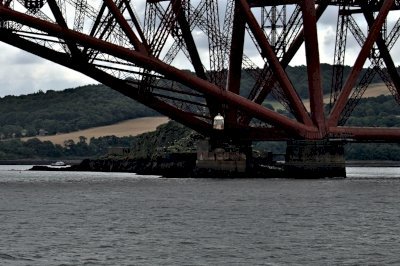
I enthusiastically agree with Squiffy’s assessment that the best way to view the Forth Bridge is from the water. Both the Maid of the Forth and Forth Tours are operating again in the summer of 2021 after closing during lockdown. Having crossed the bridge many times on various trains in the past, one sunny August day I decided to head up to Edinburgh to get a better look. There are regular trains from Edinburgh Waverley northward that cross the Forth Bridge but typically only local services to Glenrothes with Thornton or Cowdenbeath stop at the two stations on either end of the bridge, Dalmeny and North Queensferry. I disembarked at Dalmeny, the station on the south side before the bridge, and from there followed a narrow path through the woods from the station that passed beneath the beginnings of the rail bridge then descended a steep set of stairs onto the waterfront. Of the two companies operating tours, I had picked the Maid of the Forth for no reason in particular but, as of August 2021, both required pre-booking online due to reduced occupancy on the boats. In future they may return to offering the option to buy tickets on the day, with both having ticket offices next to the pier from which both cruises depart. Reassuringly, the pier also houses an RNLI lifeboat station so, in the unlikely event of trouble on the water, help is not far away.
The Forth Bridge is an impressive sight from any angle but passing underneath it reinforces the sense of its enormous scale. Despite being over 130 years old, it still has the second-longest cantilever bridge span in the world with two 520 metre spans and a total length of 2467 metres. The cruise leaves the bridge behind, heading out into the Firth of Forth to view seals, sea birds and the medieval abbey on Inchcolm. From here there are clear views south to the skyline of Edinburgh, providing a new perspective on another World Heritage Site. After visitors for the island disembark, the boat returns to pass beneath the Forth Bridge again. On this pass, the on-board commentary pointed out a small lighthouse constructed on brick foundations beneath the bridge on the small island of Inchgarvie (picture attached). This brick foundation is all that remains of the first attempt to build a bridge here, begun in 1878 designed by Thomas Bouch. The following year, the rail bridge Bouch built across the River Tay further north collapsed in heavy winds as a train crossed, killing all on board. Bouch’s suspension bridge design for the Forth Bridge was abandoned and the steel cantilever design of Sir John Fowler and Sir Benjamin Baker was eventually begun in 1882, reaching completion in 1890 and has been in use ever since.
Our 1.5 hours on the water concluded by passing under the two newer road bridges over the Firth of the Forth before returning to the pier. It had provided some magnificent views with insightful pre-recorded commentary that I can highly recommend as being worth the price of admission at now £16 per adult but be warned that the winds can be strong on the open upper deck. Whilst this is supposedly one of the driest places in Scotland, as rain falls on the hills either side of the river leaving nothing to fall on the water itself, the exposed setting leads to being blasted by the wind even on what seems like a calm day on the shore. From the pier, I headed east on foot along the shore through some pleasant if unremarkable parkland then turned right and uphill for a great view of the three bridges beyond a field of golden wheat. These are such imposing structures I imagine there are similarly spectacular vantage points all around here on both sides of the Forth. Unfortunately, the top of the hill was covered in trees and there was no 360° panoramic view from the summit and so I returned through the woods to the station for one of the frequent trains back to Edinburgh. The footbridge at Dalmeny station offered one last view of the Forth Bridge before departure, an iconic structure and a remarkable achievement of engineering given that the Bessemer process that made steel widely available was invented less than 30 years earlier.
More on
Comments
No comments yet.
